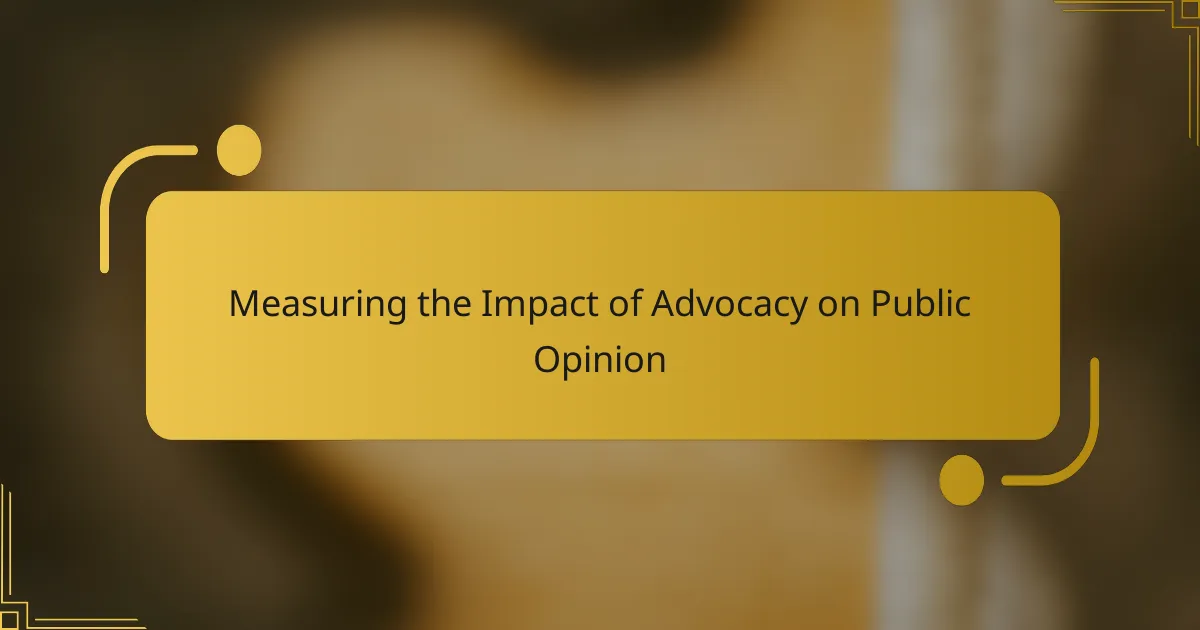Advocacy plays a crucial role in shaping public opinion by raising awareness and influencing voter behavior on important social issues. To measure its impact, various methods such as surveys, social media analytics, and focus groups are employed, each providing valuable insights into how perceptions and attitudes are swayed. Key metrics like public sentiment analysis and engagement rates help organizations assess the effectiveness of their advocacy efforts and their influence on legislative outcomes.
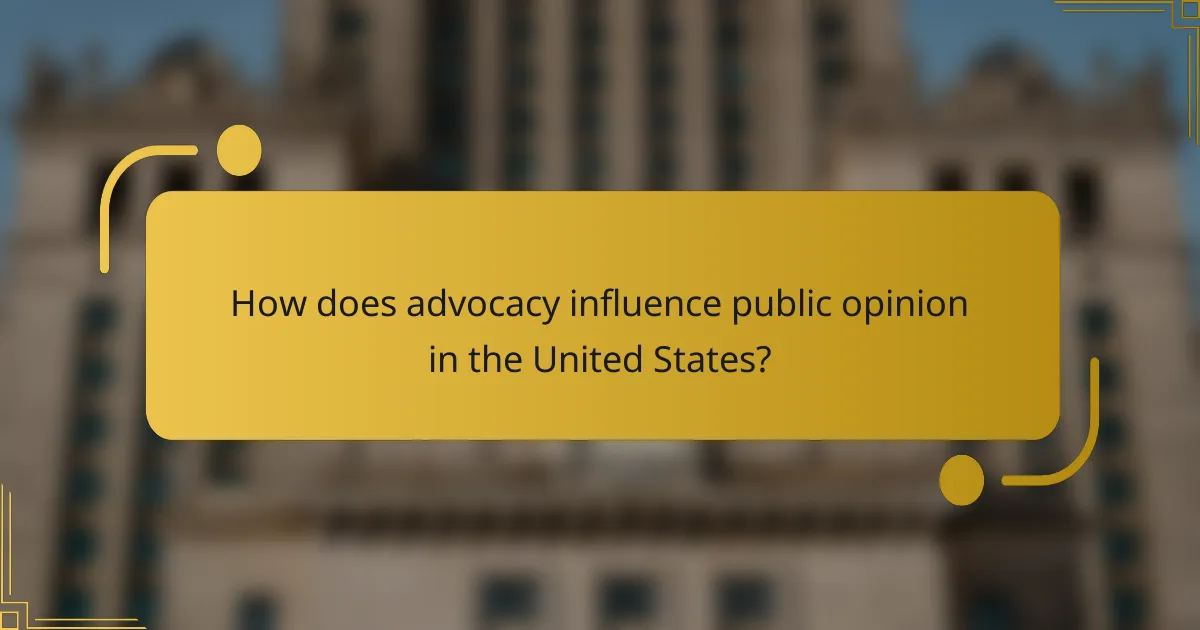
How does advocacy influence public opinion in the United States?
Advocacy significantly shapes public opinion in the United States by raising awareness, influencing voter behavior, and fostering community involvement. Through targeted campaigns and grassroots efforts, advocacy groups can effectively sway perceptions and attitudes on various social issues.
Increased awareness of social issues
Advocacy plays a crucial role in increasing public awareness of social issues by disseminating information and highlighting underrepresented topics. Campaigns often utilize social media, public events, and educational materials to inform the public about critical matters such as climate change, healthcare access, and social justice.
For example, movements like Black Lives Matter have successfully brought issues of racial inequality to the forefront of national conversations, prompting discussions across various platforms. This heightened awareness can lead to increased public interest and demand for policy changes.
Shifts in voter behavior
Advocacy can lead to notable shifts in voter behavior, particularly during election cycles. When advocacy groups mobilize supporters around specific issues, they can influence how individuals vote, often swaying them towards candidates who align with their values and priorities.
Research indicates that voters are more likely to support candidates who actively address the issues they care about, such as environmental policies or healthcare reforms. This shift can be seen in various elections where advocacy campaigns have successfully increased turnout among specific demographic groups.
Enhanced community engagement
Advocacy fosters enhanced community engagement by encouraging individuals to participate in local initiatives and discussions. Community-based advocacy efforts often lead to increased volunteerism and participation in civic activities, as individuals feel empowered to make a difference.
For instance, local advocacy groups may organize town hall meetings, workshops, or community service events that not only address pressing issues but also strengthen community bonds. This engagement can create a more informed and active citizenry, ultimately leading to more responsive governance.
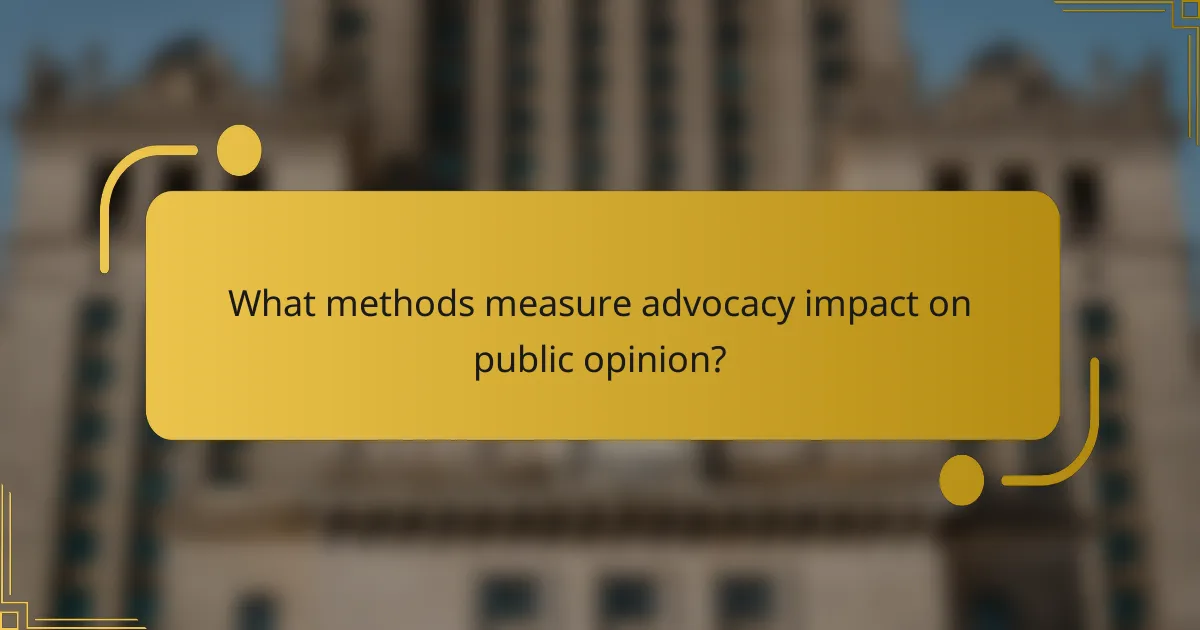
What methods measure advocacy impact on public opinion?
Measuring the impact of advocacy on public opinion involves various methods that provide insights into how advocacy efforts influence perceptions and attitudes. Common approaches include surveys, social media analytics, and focus groups, each offering unique advantages and considerations.
Surveys and polls
Surveys and polls are fundamental tools for assessing public opinion changes resulting from advocacy efforts. They can be conducted online, via telephone, or in person, allowing for a broad reach across different demographics.
When designing surveys, it’s crucial to formulate clear and unbiased questions to capture accurate data. Consider using a mix of closed and open-ended questions to gain both quantitative and qualitative insights. For example, a poll might ask respondents to rate their support for a policy on a scale from 1 to 5.
Social media analytics
Social media analytics involve tracking engagement metrics, sentiment, and reach to evaluate how advocacy campaigns resonate with the public. Platforms like Twitter, Facebook, and Instagram provide tools to measure likes, shares, comments, and overall engagement rates.
To effectively use social media analytics, focus on key performance indicators (KPIs) such as engagement rate and sentiment analysis. For instance, a significant increase in positive mentions of a campaign hashtag can indicate a favorable shift in public opinion. Regularly monitoring these metrics helps refine advocacy strategies in real-time.
Focus groups
Focus groups provide qualitative insights by gathering a small, diverse group of individuals to discuss their opinions on specific advocacy topics. This method allows for in-depth exploration of attitudes and motivations that surveys may not capture.
When conducting focus groups, ensure a skilled moderator guides the discussion to elicit honest feedback. Consider using a mix of participants to represent different viewpoints. For example, a focus group discussing environmental policies might include activists, skeptics, and neutral individuals to gauge a range of perspectives.
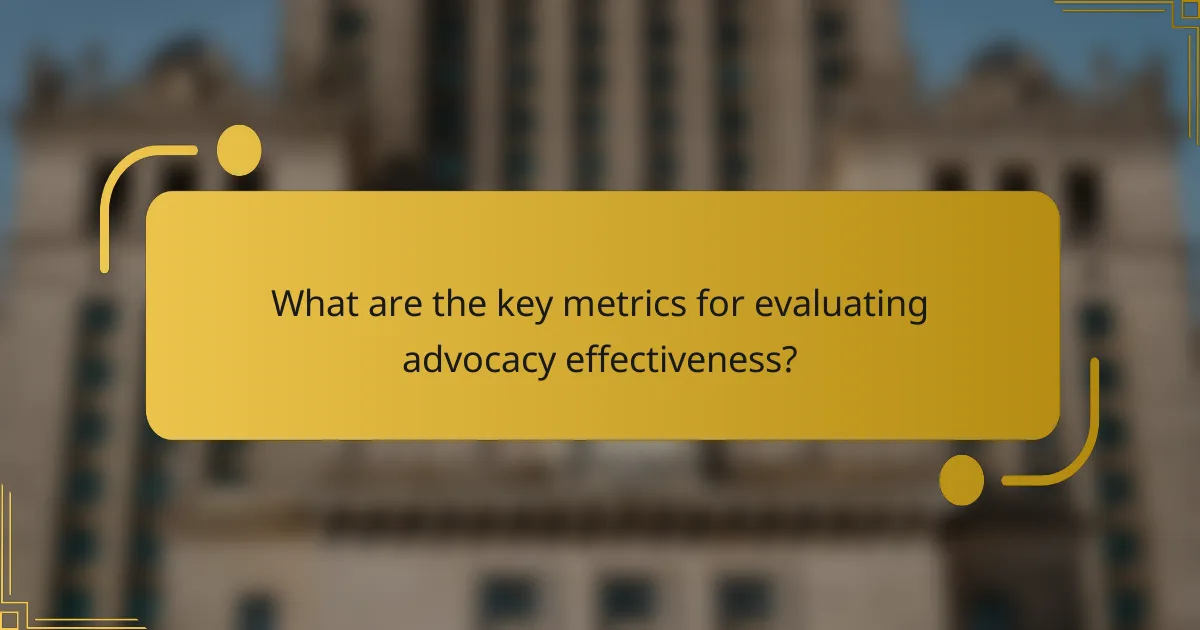
What are the key metrics for evaluating advocacy effectiveness?
Key metrics for evaluating advocacy effectiveness include public sentiment analysis, engagement rates, and tracking policy changes. These metrics help organizations understand how their advocacy efforts influence public opinion and drive legislative outcomes.
Public sentiment analysis
Public sentiment analysis involves assessing the attitudes and opinions of the public towards specific issues or campaigns. This can be achieved through social media monitoring, surveys, and sentiment analysis tools that quantify positive, negative, or neutral feelings.
To effectively analyze sentiment, organizations should regularly collect data from various platforms and demographic groups. This approach can reveal shifts in public opinion over time, helping to tailor advocacy strategies accordingly.
Engagement rates
Engagement rates measure how actively the public interacts with advocacy efforts, such as social media posts, events, or campaigns. High engagement rates often indicate strong interest and support, while low rates may suggest a need for strategy adjustments.
Common metrics for engagement include likes, shares, comments, and attendance at events. Organizations should aim for a balanced approach, focusing on both quantity and quality of engagement to foster deeper connections with their audience.
Policy change tracking
Tracking policy changes is crucial for evaluating the direct impact of advocacy efforts on legislation. This involves monitoring proposed bills, amendments, and final outcomes to determine whether advocacy campaigns have influenced decision-makers.
Organizations should establish a clear timeline for tracking policy developments and maintain communication with stakeholders to assess the effectiveness of their advocacy strategies. Regularly reviewing these changes can provide insights into what works and what needs improvement in future campaigns.
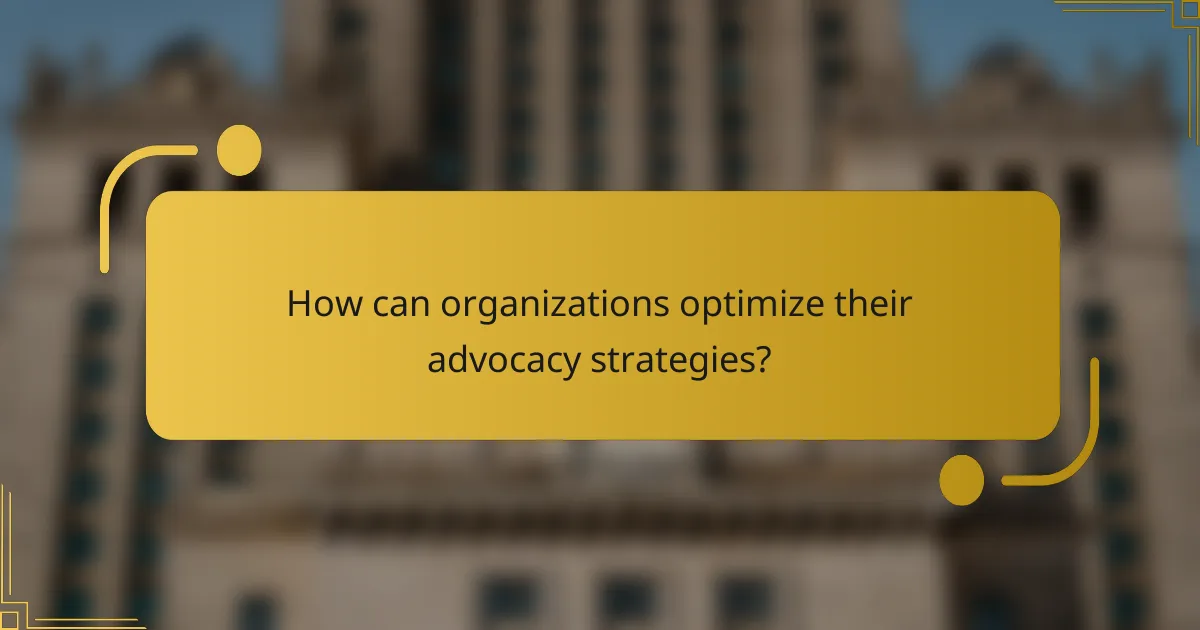
How can organizations optimize their advocacy strategies?
Organizations can optimize their advocacy strategies by focusing on targeted messaging, leveraging data for decision making, and forming partnerships with influencers. These approaches help ensure that advocacy efforts resonate with the intended audience and effectively shape public opinion.
Targeted messaging
Targeted messaging involves crafting communication that speaks directly to the values and concerns of specific audience segments. By understanding the demographics and preferences of their target groups, organizations can tailor their messages to increase engagement and impact.
For example, an environmental advocacy group might focus on local pollution issues when addressing community members, while emphasizing global climate change for a broader audience. This approach ensures that the message is relevant and compelling, leading to greater support.
Data-driven decision making
Data-driven decision making allows organizations to base their advocacy strategies on empirical evidence rather than assumptions. By analyzing public opinion surveys, social media metrics, and engagement statistics, organizations can identify which messages and tactics are most effective.
For instance, if data shows that a significant portion of the target audience is concerned about healthcare access, advocacy efforts can be directed towards that issue. Regularly reviewing data helps organizations adapt their strategies to changing public sentiments and maximize their impact.
Partnerships with influencers
Forming partnerships with influencers can amplify advocacy messages and reach wider audiences. Influencers often have established trust with their followers, making their endorsements particularly powerful in shaping public opinion.
Organizations should identify influencers whose values align with their advocacy goals and collaborate on campaigns or initiatives. This could involve co-hosting events, creating joint content, or leveraging social media platforms to spread awareness effectively.
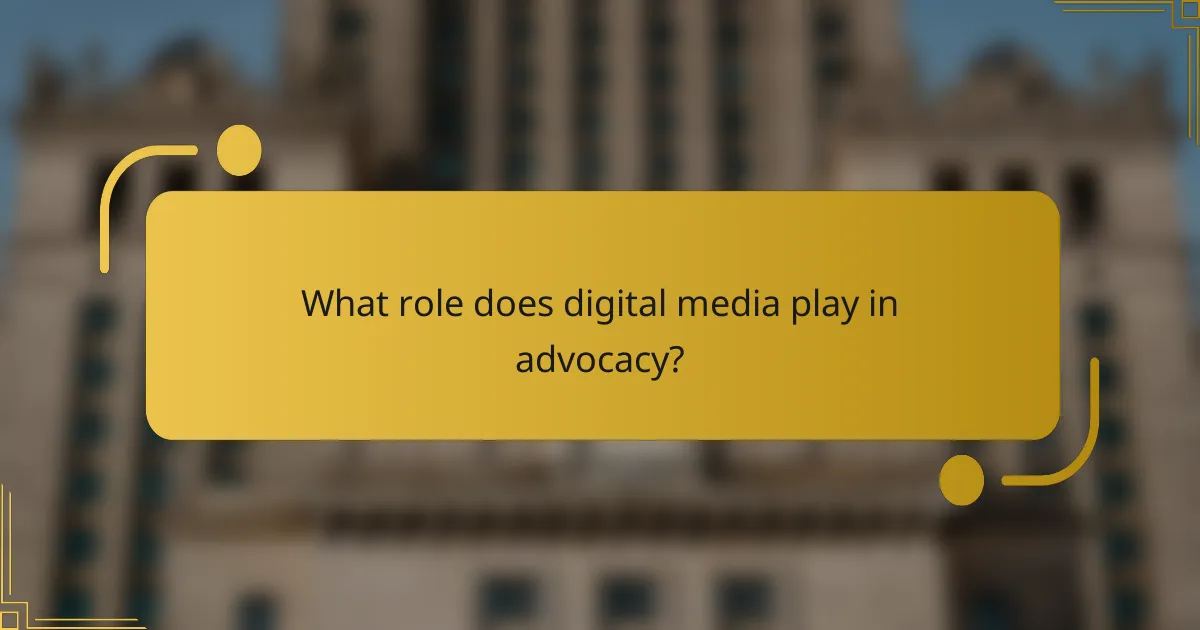
What role does digital media play in advocacy?
Digital media plays a crucial role in advocacy by providing platforms for organizations and individuals to communicate their messages effectively and reach broader audiences. It enables advocates to share information, mobilize support, and influence public opinion in real time.
Amplifies reach
Digital media significantly amplifies the reach of advocacy efforts by allowing messages to spread quickly across various platforms. Social media channels, blogs, and websites can help campaigns reach thousands or even millions of people, far exceeding traditional methods like print or broadcast media.
For example, a single tweet or post can go viral, drawing attention to a cause and encouraging others to share it further. This network effect can lead to exponential growth in visibility and engagement.
Facilitates grassroots movements
Digital media facilitates grassroots movements by connecting individuals who share common goals and values. Online platforms allow like-minded people to organize, collaborate, and mobilize for action, often leading to significant local and national impact.
Tools like crowdfunding sites and petition platforms enable advocates to gather resources and support quickly. For instance, a community can rally around a local issue, using social media to coordinate events and share updates, thus strengthening their collective voice.
Enables real-time feedback
Digital media enables real-time feedback, allowing advocates to gauge public opinion and adjust their strategies accordingly. Through social media interactions, surveys, and analytics, organizations can quickly assess how their messages are being received and what resonates with their audience.
This immediate feedback loop helps refine advocacy efforts, ensuring that campaigns remain relevant and impactful. For example, if a particular message garners a strong response, advocates can amplify that message further, while less effective strategies can be modified or abandoned.

What are common challenges in measuring advocacy impact?
Measuring the impact of advocacy on public opinion presents several challenges that can complicate the evaluation process. Key issues include difficulties in attributing changes in opinion directly to advocacy efforts and concerns regarding data privacy that can limit access to necessary information.
Attribution difficulties
Attributing shifts in public opinion to specific advocacy campaigns can be challenging due to the multitude of influencing factors. Events, media coverage, and social movements can all contribute to changes in public sentiment, making it hard to isolate the effect of advocacy efforts. For instance, if a campaign coincides with a significant news event, it may be unclear how much influence the advocacy had on public perception.
To navigate this, consider using control groups or pre- and post-campaign surveys to gauge changes in opinion more accurately. Employing mixed-method approaches, such as qualitative interviews alongside quantitative data, can also provide a clearer picture of advocacy impact.
Data privacy concerns
Data privacy issues can hinder the measurement of advocacy impact by restricting access to personal information needed for analysis. Regulations like the General Data Protection Regulation (GDPR) in Europe impose strict guidelines on how personal data can be collected and used, which can limit the scope of research. This makes it difficult to track changes in individual opinions over time.
To address these concerns, advocates should prioritize transparency and ethical data collection practices. Utilizing anonymized data and ensuring compliance with local regulations can help mitigate risks while still allowing for meaningful analysis of advocacy impact.
